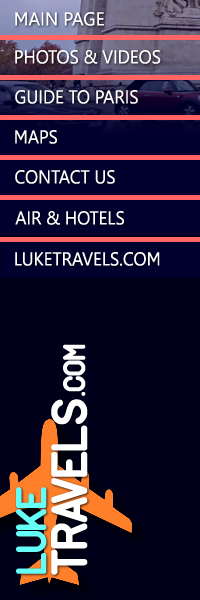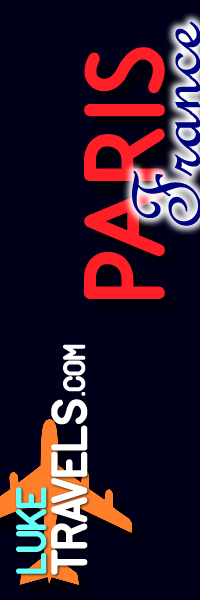PARIS: History of the City
Paris, the cosmopolitan capital of France, is one of the largest
cities in Europe with population exceeding 10 million residents.
Located in the north of the country on the river Seine, Paris
has the reputation of being the most beautiful and romantic of
all cities, brimming with historic associations and remaining
vastly influential in the realms of culture, art, fashion, food
and design. Dubbed the City of Lights, it is the most popular
tourist destination in the world.
The name "Paris" is derived from that of some of its early
inhabitants, the Celtic tribe known as the Parisii. The city was
called Lutetia (more fully, Lutetia Parisiorum, "Lutetia of the
Parisii"), during the Roman era of the 1st to the 4th century
AD, but during the reign of Julian the Apostate (360–3), the
city was renamed Paris. It is believed that the name of the
Parisii tribe comes from the Celtic Gallic word parisio, meaning
"the working people" or "the craftsmen"
The history of Paris, France, spans over 10,000 years, during
which time the city grew from a small Mesolithic settlement to
the largest city and capital of France. It further developed
into a center of art, medicine, science, fashion, tourism, high
culture and high finance, becoming one of the world's major
global cities.
Paris started life as the Celto-Roman settlement of Lutetia on
the Ile de la Cité, the island in the Seine currently occupied
by the Cathédral de Nôtre Dame. It takes its present name from
the name of the dominant Gallo-Celtic tribe in the region, the
Parisii. At least that's what the Romans called them, when they
showed up in 52 BCE and established their city Lutetia on the
left bank of the Seine, in what is now called the "Latin
Quarter" in the 5th arrondissement.
The Romans held out in this area for as long as anywhere else in the
Western Empire, but by 508 they were gone, replaced by Clovis of
the Franks, who is considered by the French to be their first
king. Clovis' descendants, aka the Carolingians, held on for
nearly 500 years though Viking raids and other calamities forced
a move by most of the population back to the islands which had
been the center of the Celtic village. The Capetian Duke of
Paris was voted to succeed the last of the Carolingians as king
of France, insuring the city of its premier position in the
medieval world. Over the next several centuries Paris expanded
onto the right bank into what was called le Marais (the marsh).
Quite a few buildings from this time can be seen in the 4th
arrondissement.
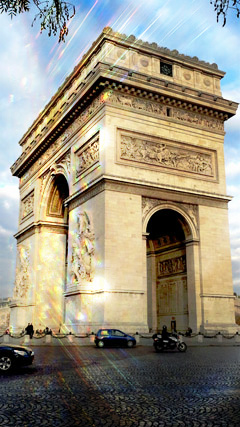

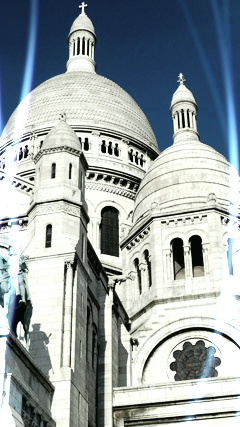

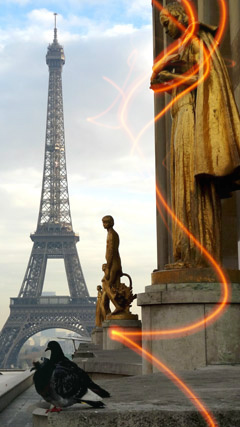

The medieval period also witnessed the founding of the Sorbonne.
As the "University of Paris", it became one of the most
important centers for learning in Europe, if not the whole
world, for several hundred years. Most of the institutions that
constitute the University are found in the 5th, and 13th
arrondissements.
The Capetian and later the Bourbon kings of France made their
mark on Paris with such buildings as the Louvre and the Palais
Royal, both in the 1st, but the Paris which most visitors know
and love was built long after they were gone in the 19th
century. This was when Baron von Hausmann reconstructed adding
the long straight avenues, and demolishing many of the medieval
houses which had been left until that time.
During the latter half of the 18th century, Paris became the
intellectual and cultural capital of the Western world. Its many
"philosophers" made it the main centre of the Enlightenment with
its salons becoming the center of the new thinking of the "Age
of Reason." This was positively encouraged by the state, with
Louis's mistress Madame de Pompadour supporting the city's
intellectuals and prompting the king to construct striking new
monuments. In 1686, François Procope established the first café
in Paris, the Café Procope. By the 1720s there were around 400
cafés in the city. The Café Procope in particular became a
centre of Enlightenment, welcoming such celebrities as Voltaire,
Rousseau, Diderot and D’Alembert.[11] Robert Darnton in
particular has studied Parisian café conversation in great
detail, showing how the cafés became "nerve centers" for bruits
publics, public noise or rumor. These bruits were trusted more
than the newspapers available at the time.
Under Louis XVI, Paris reached new heights of prestige as a
center of the arts, sciences and philosophy. The French Academy
of Sciences was founded in 1666 in Paris. It was closely tied to
the French state, acting as an extension of a government
seriously lacking in scientists. It helped promote and organize
new disciplines, and it trained new scientists. It also
contributed to the enhancement of scientists’ social status,
considered them to be the "most useful of all citizens".
Academies demonstrate the rising interest in science along with
its increasing secularization, as evidenced by the small number
of clerics who were members.
New wonders arrived during la Belle Époque, as the Parisian
golden age of the late 19th century is known. Gustave Eiffel's
famous tower, the first metro lines, most of the parks, and the
streetlights, which are partly believed to have given the city
its epithet "the city of light" all come from this period. The
epithet actually comes from Ville Lumière, a reference not only
to the then revolutionary electrical lighting system implemented
in the streets of Paris, but also to the prominence and aura of
Enlightenment the city gained in that era.
The twentieth century was hard on Paris, but thankfully not as
hard as it could have been. Hitler's order to burn the city was
thankfully ignored by the German General von Choltitz who was
quite possibly convinced by a Swedish diplomat that it would be
better to surrender and be remembered as the savior of Paris,
than to be remembered as its destroyer. Following the war the
city recovered slowly at first, and then more quickly in the
1970s and 1980s when Paris began to experience some of the
problems faced by big cities everywhere: pollution, housing
shortages, and occasionally failed experiments in urban renewal.
PARIS: Population Evolution
During 1970-1980s, Paris experienced considerable growth as a
multi-cultural city, with new immigrants from all corners of the
world, especially la francophonie, including most of northern
and western Africa as well as Vietnam and Laos.
These immigrants brought their foods and music both of which are
of prime interest for many travelers. Today, there are more
nationalities represented in Paris than even in New York City.
Immigration and multi-culturalism continues! The 21st century
has seen a marked increase in the arrival of people from Latin
America, especially Mexico, Colombia, and Brazil. In the late
1990s it was hard to find good Mexican food in Paris, however,
today there are dozens of possibilities from lowly taquerias in
the outer arrondissements to nice sit-down restaurants on the
boulevards. The chili pepper has arrived.
The 21st century has also seen vast improvements in the general
livability of Paris, with the Mayor's office concentrating on
reducing pollution and improving facilities for soft forms of
transportation including a huge network of cycle paths, larger
pedestrian districts and newer faster metro lines. Visitors who
normally arrive car-less are the beneficiaries of these policies
as much as the Parisians themselves are.
PARIS: Climate and Weather
Being located in Western Europe, Paris has a maritime climate
with cool winters and warm summers. The moderating effect of the
Atlantic Ocean helps to temper temperature extremes in much of
western Europe, including France. Even in January, the coldest
month, temperatures nearly always exceed the freezing point with
an average high of 6°C (43°F). Snow is not common in Paris,
although it will fall a few times a year. Most of Paris'
precipitation comes in the form of light rain year-round.
Summers in Paris are warm and pleasant, with an average high of
23°C (75°F) during the mid-summer months. Spring and fall are
normally cool and wet.
With the weather being so pleasant in the summer, it's a great
time to visit.
PARIS: Economy
The Paris Region is France's premier centre of economic
activity, and with a 2011 GDP of €607 billion (US$845 billion),
it is not only the wealthiest area of France, but has one of the
highest GDPs in the world, after Tokyo, New York, Los Angeles,
Seoul and London making it an engine of the global economy. Were
it a country, it would rank as the seventeenth-largest economy
in the world, larger than the Turkish and Dutch economies and
almost as large as Indonesia's. While its population accounted
for 18.8 percent of the total population of metropolitan France
in 2011, its GDP accounted for 31.0 per cent of metropolitan
France's GDP. Wealth is heavily concentrated in the western
suburbs of Paris, notably Neuilly-sur-Seine, one of the
wealthiest areas of France. This mirrors a sharp political
divide, with political conservatism being much more common
towards the western edge, whilst the political spectrum lies
more to the left in the east.
The Parisian economy has been gradually shifting towards
high-value-added service industries and high-tech manufacturing.
However, in the 2009 European Green City Index, Paris was still
listed as the second most "green" large city in Europe, after
Berlin. The Paris region's most intense economic activity
through the central Hauts-de-Seine département and suburban La
Défense business district places Paris' economic centre to the
west of the city, in a triangle between the Opéra Garnier, La
Défense and the Val de Seine. While the Paris economy is largely
dominated by services, it remains an important manufacturing
powerhouse of Europe, especially in industrial sectors such as
automobiles, aeronautics, and electronics. The Paris Region
hosts the headquarters of 30 of the Fortune Global 500 companies
Special thanks to Wikitravel,
Wikipedia and its authors

